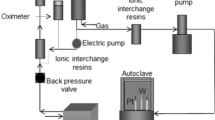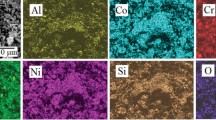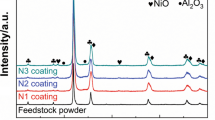Abstract
In this work, the oxidation resistance of 304 stainless steel (SS) in the uncoated and nanoceria-coated conditions was investigated at 1073 K and 1273 K (800 °C and 1000 °C) under dry air conditions. It was found that nanoceria coatings with average particle sizes of 10 nm were effective enough to fully protect the 304 SS from oxidation. In particular, when the average nanoceria particle size in the coating was less than 5 nm, the coatings were highly efficient in hindering the oxidation susceptibility of the 304 SS. Improvements in the oxidation resistance of up to two orders of magnitude were experimentally found in this work. Finite elements were used in solving Fick’s Second Law using the Crank–Nicholson method in order to elucidate the active oxidation mechanisms in the bare and nanoceria-coated 304 SS. Oxygen penetration profiles across the scale were predicted suggesting that in the absence of a nanoceria coating, the oxygen concentration at a given scale depth is three times as high as in the nanoceria-coated samples. Moreover, kinetic simulations for scale growth through an exponential term containing a factor λ were satisfactory in predicting the experimental outcome on mass gain vs time. Ostwald-Ripening mechanisms were considered to be active during the dissolution of nanoceria particles. It was found that when average particle sizes fall below 5 nm in size, they tend to dissolve immediately, but the dissolution times become exceedingly long when the particle sizes increase above 10 nm.







Similar content being viewed by others
References
D. P. Moon and M. J. Bennett, Mater. Sci. Forum, vol. 43, pp. 269-298, 1989.
E. A. Polman, T. Fransen and P. J. Gellings, J. Phys.Condens. Matter, vol. 1, pp. 4497-4510. 1989.
J. Stringer, Mater. Sci. Eng. A, vol. 120, pp. 129–3,1989.
D. P. Moon, Mater. Sci. Technol., vol. 5, pp. 754-60, 1989.
L.B. Pfeil: U.K. Patent No. 459848, 1937.
B. A. Pint, Oxid. Met. vol. 45, pp. 1-37, 1996.
F. Czerwinski and J. A. Szpunar, J. Sol-Gel Science and Technology, vol. 9, pp 103-114, 1997.
F. Czerwinski and J. A. Szpunar, Thin Solid Films, vol. 289, pp. 213–219, 1996.
S. Roure, E. Czerwinski and A. Petric, Oxid. Metals, vol. 42, pp. 75-102, 1994.
F. Czerwinski and W.W. Smeltzer, Oxid. Metals, 1993, vol. 40, pp. 503–27.
S. Seal, S. K. Bose and S. K. Roy, Oxid. Metals, vol 41, pp. 139-178, 1994.
V.Viswanathan, R. Filmalter, S. Patil, S. Deshpande and S. Seal, J. Am. Ceram. Soc., Vol. 90, pp. 870-877, 2007.
R. Thanneeru, S. Patil, S. Deshpande and S. Seal, Acta Mater., vol. 55, pp. 3457-3466, 2007.
S. Patil, S. C. Kuiry, S. Seal and R. Vanfleet, J. Nanopart. Res.,vol.4, pp. 433-438, 2002.
E. M. Levin, and H. F. McMurdie: Phase Diagrams for Ceramists, The American Ceramic Society, Columbus, OH, 1975.
H. Zhang and H. F. Lopez, Comp. Mats. Sci., Vol. 79, pp. 634-638, 2013.
Z. Wu, L. Guo, H. Li, R.E. Benfield, Q. Yang, D. Grandjean, Q. Liand, H. Zhu: J. Phys., 2001, vol. 13, pp. 5269–84.
C. E. Reis-de-Carvalho, G. M. da Acosta, A. B. Cota and E. H. Rossi, Mats. Res. Vol. 9, pp. 393-397, 2006.
K.A. Habib, M.S. Damra, J.J. Saura, I. Cervera, and J. Bellés: Int. J. Corr., 2011, vol. 20, DOI: 10.1155/2011/824676.
P. Kofstad, High-Temperature Oxidation of Metals, John Wiley & Sons, Inc., New York/London/Sydney, 1966.
B. Pieraggi, R. A. Rapp, J. Electrochem. Soc. vol. 140, pp. 2844-2850, 1993.
D. L. Douglass, P. Kofstad, A. Rahmel, G. C. Wood, Oxid. Met. vol. 45, pp. 529-620, 1996.
H. Zhang: Ph.D. Dissertation, University of Wisconsin, 2007.
H.F. Lopez and H. Mendoza-Del-Angel: Symposium 5 Advanced Materials, XIX Intl. Congress of Mats. Research, August 15–19, Cancun 2010. Conf. Proc., MRS, vol. 1276, pp. 123–28.
S. Tsunekawa, K. Ishikawa, Z. Q. Li, Y. Kawazoe and A. Kasuya, Phys. Rev. Lett., vol. 85, pp. 3440-3443, 2000.
X. D. Zhou and W. Huebner, Appl. Phys. Lett., vol. 79, pp. 3512-14, 2001.
H. Nagai and M. Okabayashi, J. Trans. Japan Inst. Metals, vol. 22, pp. 101-108, 1982.
P. Wynblatt and N. A. Gjostein, Acta Metall., vol. 24, pp. 1165-117, 1976.
P. Wynblatt, R.A. DallaBetta, and N.A. Gjostein: in The Physical Basis For Heterogeneous Catalysts, E. Drangles and R.I. Jafee, eds., Plenum Press, New York, 1975.
H. T. Michels, Metall, Trans. A, vol. 7A, pp. 379-88, 1976.
S.R. Challa, A. Delariva, and A. K. Datye: 22th North Am. Mtg., Detroit Michigan June 5–10, 2011.
C.T. Campbell, S.C. Parker, and D.R. Starr: Science, 2002, vol. 298, pp. 811–814.
M. Kamiya, E. Shimada, Y.Ikuma, M. Komatsu, and H. Haneda: J. Electrochem. Soc., 2000, vol. 147, pp. 1222–1227.
A. Gotte: Ph.D. Dissertation, Uppsala University, Uppsala, 2006.
T. X. Sayle, S. C. Parker and C. R. A. Catlow, Surface Science, vol. 316, pp. 329-336, 1994.
B. Carnahan: Applied Numerical Methods, John Wiley & Sons, Inc., New York, 1969.
J. Crank, The Mathematics of Diffusion, 2nd edition, Clarendon-Press, Oxford, 1986.
Acknowledgments
The authors are grateful for the support provided by The National Computational Science Alliance (NCSA) at the University of Illinois at Urbana-Champaign under Grant DMR060004N.
Author information
Authors and Affiliations
Corresponding author
Additional information
Manuscript submitted April 7, 2013.
Appendix A
Appendix A
1.1 Crank–Nicholson Method
In general, the driving force for high temperature oxidation processes is rate limited by the active mass transport mechanisms across the scale thickness. Under these conditions, Fick’s Second Law can be used when considering the diffusional processes.
where c is the concentration of a given species after time t and its gradient by means of the location, x, and D is the diffusion coefficient. For two-dimensional (2-D) diffusional problems, and assuming that the diffusion coefficients are not dependent on position, Eq. [1] can be rewritten as
where D x and D y are the diffusion coefficients in x and y directions, respectively. A solution to the 2-D form of Fick’s Second Law requires both initial conditions and subsequent time-dependent boundary conditions.[35] Hence, in this work, a network of grid points was employed to solve Eq. [A2] using the Crank–Nicholson method.[36] In this case, Eq. [A2] can be rewritten as
The finite-difference Eq. [A3] with locations of variable step widths, Δx, Δy, and Δt, is illustrated in Figure A1. The scale is assumed to be predominantly Cr2O3 and the boundary concentrations are assumed (i) to be homogeneous and (ii) to experience only relatively small changes; Eq. [A3] can be solved using the Gaussian elimination method and the Gauss–Seidel iterative method. This entire process was implemented in MATLAB.
The diffusional data needed for the finite-difference calculations were obtained by considering Wagner’s oxidation theory,[20] as given in the literature[37]:
where D eff is the effective diffusion coefficient, P O2 is the partial oxygen pressure, and K p is the parabolic oxidation rate constant. In the present work, D x and D y were replaced by D eff. In the numerical simulation, the scale/substrate interface including gbs was represented by a row of high diffusivity elements (see Figure A2). Close to the surface, the mesh was continuously refined to get a more precise solution on the overall diffusion across the oxide scale.
Rights and permissions
About this article
Cite this article
Lopez, H.F., Zhang, H. The Effect of Particle Size on the Oxidation Resistance of a Nanoceria-Coated 304 Stainless Steel. Metall Mater Trans A 45, 2297–2308 (2014). https://doi.org/10.1007/s11661-013-2159-z
Published:
Issue Date:
DOI: https://doi.org/10.1007/s11661-013-2159-z






